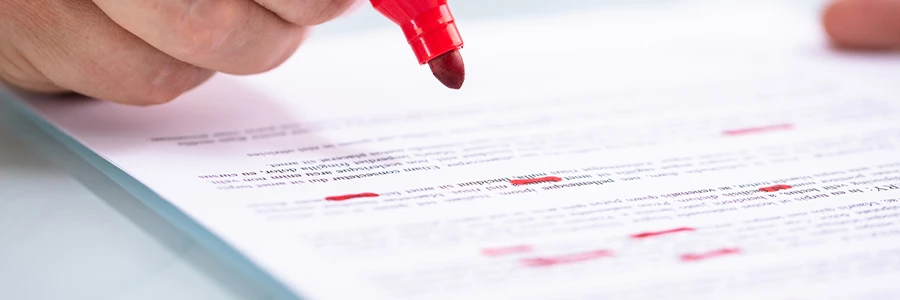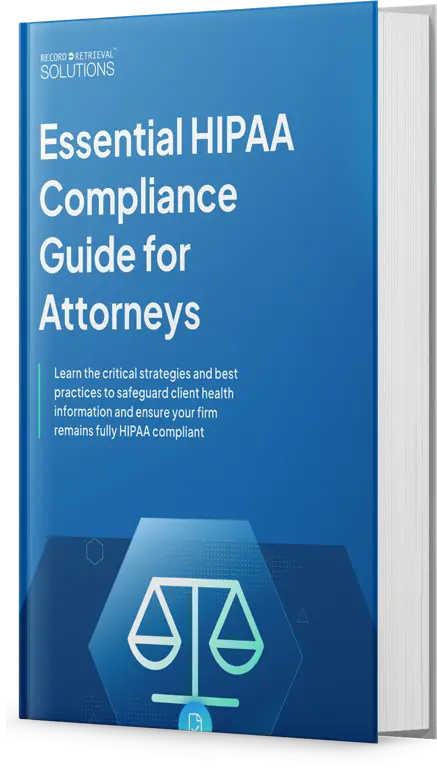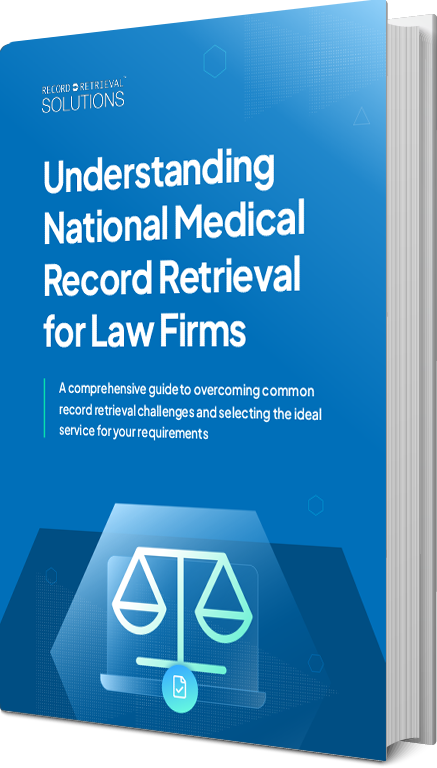Key Takeaways
- An errata sheet is a supplemental document allowing a deponent (witness) to correct errors or clarify statements in a deposition transcript.
- It does not replace the transcript but becomes part of the court record under Rule 30(e) (or equivalent local rule).
- Courts differ in how much substantive change they allow: minor corrections are safer; major shifts may be challenged or lead to reopening.
- For legal teams handling medical-record–intensive cases, a strong partner like Record Retrieval Solutions (RRS) is crucial. RRS’s role in mitigating risk by ensuring accuracy and supporting defensible errata changes is a source of reassurance and confidence.
- Thoughtful planning, early review, and leveraging RRS’s record-handling diligence can reduce costly surprises, challenges, or cross-examination exposure.
Who can file an errata sheet?
- The deponent (the person deposed) — typically the witness or party — has the right to review and correct mistakes.
- It must be the deponent’s own input, not drafted solely by counsel (attorneys influencing changes may trigger credibility issues or sanctions).
- Counsel, court reporters, and opposing counsel are stakeholders: counsel should advise, but not override; the court reporter must attach errata to the transcript; opposing counsel can challenge changes.
Who cares about errata in medical cases?
In medical malpractice, insurance defense, personal injury, and healthcare litigation, deposition transcripts often delve into medical record details.
A single miswording—wrong dosage, date, lab value—can create severe liability or credibility issues.
Legal teams, claims adjusters, expert witnesses, and judges all have a vested interest in accurate transcripts.
RRS’s specialty in retrieving, indexing, and cross-checking medical records makes it uniquely positioned to support defense in these contexts.
What is the meaning and function of an errata sheet?
An errata sheet is a structured document used to correct or clarify parts of a completed deposition transcript.
It lists the page and line of the original statement, specifies the corrected version, and includes a short explanation—such as a transcription mistake, a clarification, or a misheard word. It becomes an official addendum to the transcript rather than a replacement.
It may permit changes “in form or substance” according to Federal Rule 30(e) (or analogous state/local rules) — though courts vary widely in how broadly they interpret that allowance.
What does a deposition errata sheet look like?
Common elements include:
- Page and line numbers
- Original transcription vs. corrected text
- Explanation/justification for each change
- Signature/date of deponent
- Notary or acknowledgment, where required
- A certification by the court reporter confirming the review, if applicable
Important note: The errata sheet must clearly tie each change to its location and reason. Vague or bulk statements like “for clarification” are often rejected.
When is review allowed?
Under Rule 30(e), once the court reporter notifies the parties that the transcript is available, the deponent generally has 30 days to review and return the errata sheet.
Some jurisdictions or local rules may shorten or extend that window. For instance, in Texas, the period may be 20 days under specific regulations.
When should corrections be done?
- Immediately after the transcript is available, prompt review catches minor transcription slips (e.g., misspelled medical terms, homonyms).
- Before major deadlines (discovery cutoffs, summary-judgment motions), to avoid surprises.
- Before trial so that that counsel can anticipate and manage objections or reopenings.
When are substantial changes risky?
- Late in the case, after dispositive motion briefing, changes may invite objections or be challenged as a “sham.”
- Contradicting core testimony without strong justification may lead opposing counsel to move to strike or reopen the deposition.
- If the change makes the original testimony “incomplete or useless,” courts may grant relief to the opposing side (e.g., reopening) or penalize counsel.
Why does the errata sheet process matter?
- Transcript errors are inevitable. Even the best reporter may mishear medical jargon, drug names, or lab values.
- Litigation leverage. Errata may shift interpretation or meaning in key passages — but if challenged, they may hurt credibility more than help.
- Cross-examination exposure. Opposing counsel can use original vs. errata discrepancies to impeach the witness.
- Costly surprises. Missed or mishandled corrections may lead to motion practice, reopenings, or sanctions.
How can RRS help?
- Medical-record cross-reference integrity: RRS retrieves, indexes, and annotates medical records. Before deposition, counsel and experts can cross-check the transcript vs. actual records to spot likely inconsistencies.
- Pre-deposition readiness: RRS can pre-flag high-risk medical terms, lab values, diagnoses, dates, or narrative inconsistencies so the deponent is aware.
- Support during errata drafting: While the deponent must supply corrections, RRS can assist in verifying that the correction aligns with the actual record (not guesswork).
- Audit trail defensibility: RRS tracks chain-of-custody and versioning — helpful if errata changes are challenged (to show the change was grounded in the original record, not post hoc rewriting).
- Turnkey medical document support: Because RRS handles bulk medical record retrieval and organization, the legal team can focus on content rather than wrangling thousands of pages mid-case — reducing the chances of transcription errors going unnoticed.
What Are the Rules and Limitations?
How much change is allowed?
Courts interpret Rule 30(e) differently:
- “Majority rule” (broad): Allows changes in form or substance as long as properly justified. The errata becomes part of the official record while the original remains for impeachment.
- “Minority rule” (narrow): Permits only transcription or clerical corrections; substantive changes that contradict the original are disfavored or stricken.
- Case-by-case discretion: Some courts evaluate each change individually, weighing timing, importance, and justification.
Opposing counsel strategies
- Challenge vague explanations (“for clarification”) as inadequate.
- Argue specific changes are “sham” errata (i.e., tactical rewriting rather than genuine correction).
- Move to strike or reopen the deposition to explore the reasoning behind changes.
- Cross-examine the witness on the correction process, including whether counsel influenced changes.
Best practices to stay safe
- Limit changes to accurate corrections or clarifications consistent with contemporaneous record or memory.
- Provide a specific, detailed explanation for each change tied to a source or memory.
- Avoid sweeping, substantive rewriting without a strong basis.
- If a change is disputed, be prepared to defend it using the underlying medical record.
- Consider reopening only if it is necessary and defensible, rather than a blind challenge.
How to Make an Errata Sheet Strategically (Step-by-Step)
Step 1: Transcript review with checklist
- Use a medical-term checklist (lab values, diagnoses, dosages).
- Mark ambiguous or questionable passages early.
- Cross-check with medical records before drafting changes.
Step 2: Draft the errata entries
- For each change: note page/line, original text, revised text, and precise reason (e.g., “transcription error: should read 12.3 mg/dL, matching medical record”).
- Do not “add” new testimony that was not asked — stick to clarification or correction.
- Keep explanations crisp, factual, and tied to evidence.
Step 3: Review & counsel input
- Let the deponent review changes carefully in the context of the record.
- Counsel may advise, but should not override the deponent’s voice.
- Reconcile any differences of memory vs. record transparently.
Step 4: Submit within the deadline
- Ensure timely return to the court reporter within the applicable timeframe (commonly 30 days).
- The court reporter will attach the errata sheet to the transcript and note whether the changes were indicated.
Step 5: Prepare for potential challenge
- Be ready to explain each change under cross-examination using record support.
Conclusion
An errata sheet is a powerful but double-edged tool: used wisely, it corrects transcription slips, refines clarity, and protects your client’s record.
Used poorly—without justification or record support—it becomes fodder for attack, credibility loss, or motion practice.
For medical-intensive litigation in particular, the stakes are higher: a single mis-entered lab value or dosage can save or sink a case.
That’s where RRS truly shines as your strategic partner. By providing reliable retrieval, indexing, cross-checking, and defensible documentation, RRS helps transform errata from a liability into a controlled, audit-ready process.
Integrate RRS into your deposition and errata workflow early, and you’ll minimize surprises, strengthen testimony, and reclaim time and confidence in medical record–driven cases.
FAQs
What is the difference between an errata sheet and an affidavit?
An errata sheet is part of the deposition record and must be attached via the court reporter; it corrects or clarifies the original transcript under Rule 30(e). An affidavit is a separate sworn statement and may be struck or disregarded if it contradicts transcript testimony.
Can a deponent completely rewrite their testimony via errata?
That depends on the jurisdiction. Under some courts’ “majority rule,” substantive changes may be allowed (if justified). Other courts adopt a stricter view and will reject or strike fundamental changes. Always tie back to the record and timing.
What happens if opposing counsel objects to my errata changes?
They can move to strike the changes, reopen the deposition to question the deponent, or seek sanctions if they suspect improper coaching. Be prepared with a transparent justification and record support.
If I don't submit an errata, is my case doomed?
No, but you lose the chance to correct transcription errors or clarify ambiguous testimony. The original transcript remains in place, warts and all, which can undermine your case or credibility later.
How does RRS help defend errata changes?
RRS offers deep medical-record support by indexing, annotating, and preserving audit trails. If errata changes are challenged, you can show precisely how the correction mirrors the source record—not guesswork. That’s a robust defense against “sham” allegations.






